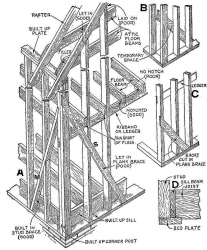
Common Definition: A type of wood framing popular in the 1800s and early 1900s.
Unauthorized Definition: Standardized dimension lumber was proposed around 1833 by builder Augustine Deodat Taylor to simplify construction. Combined with inexpensive nails available in the early 1830’s, balloon framing was invented. A system that relies on small regularly sized members evenly spaces (usually 16″ on center). For timber framers at the time, this new technique seemed lightening fast, like “blowing up a balloon”. Unfortunately, balloon framing came with two serious drawbacks. Since wall studs ran the full two stories, long straight lumber was required. With no separation between floors, fires quickly engulfed these structures.
Balloon framing isn’t common today, but is still used for vaulted ceilings with gable roofs. Blocking is now added to reduce fire spread. Platform or Western framing is now standard.
For more information see 2×4 (and other Lumber)
« Back to Glossary Index